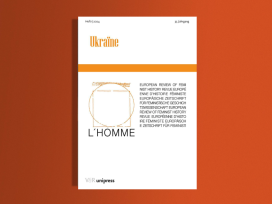Though Europe thrives, its writers and politicians are preoccupied with death. The mass killings of European civilians during the 1930s and 1940s are the reference of today’s confused discussions of memory, and the touchstone of whatever common ethics Europeans may share. The bureaucracies of Nazi Germany and the Soviet Union turned individual lives into mass death, particular humans into quotas of those to be killed. The Soviets hid their mass shootings in dark woods and falsified the records of regions in which they had starved people to death; the Germans had slave labourers dig up the bodies of their Jewish victims and burn them on giant grates. Historians must, as best we can, cast light into these shadows and account for these people. This we have not done. Auschwitz, generally taken to be an adequate or even a final symbol of the evil of mass killing, is in fact only the beginning of knowledge, a hint of the true reckoning with the past still to come.
The very reasons that we know something about Auschwitz warp our understanding of the Holocaust: we know about Auschwitz because there were survivors, and there were survivors because Auschwitz was a labour camp as well as a death factory. These survivors were largely western European Jews, because Auschwitz is where western European Jews were usually sent. After World War II, western European Jewish survivors were free to write and publish as they liked, whereas eastern European Jewish survivors, if caught behind the Iron Curtain, could not. In the West, memoirs of the Holocaust could (although very slowly) enter into historical writing and public consciousness.
This form of survivors’ history, of which the works of Primo Levi are the most famous example, only inadequately captures the reality of the mass killing. The Diary of Anne Frank concerns assimilated European Jewish communities, the Dutch and German, whose tragedy, though horrible, was a very small part of the Holocaust. By 1943 and 1944, when most of the killing of western European Jews took place, the Holocaust was in considerable measure complete. Two thirds of the Jews who would be killed during the war were already dead by the end of 1942. The main victims, the Polish and Soviet Jews, had been killed by bullets fired over death pits or by carbon monoxide from internal combustion engines pumped into gas chambers at Treblinka, Bełzec, and Sobibor in occupied Poland.
Auschwitz as symbol of the Holocaust excludes those who were at the centre of the historical event. The largest group of Holocaust victims – religiously Orthodox and Yiddish-speaking Jews of Poland, or, in the slightly contemptuous German term, Ostjuden – were culturally alien from western Europeans, including western European Jews. To some degree, they continue to be marginalized from the memory of the Holocaust. The death facility Auschwitz-Birkenau was constructed on territories that are today in Poland, although at the time they were part of the German Reich. Auschwitz is thus associated with today’s Poland by anyone who visits, yet relatively few Polish Jews and almost no Soviet Jews died there. The two largest groups of victims are nearly missing from the memorial symbol.
An adequate vision of the Holocaust would place Operation Reinhardt, the murder of the Polish Jews in 1942, at the centre of its history. Polish Jews were the largest Jewish community in the world, Warsaw the most important Jewish city. This community was exterminated at Treblinka, Bełzec, and Sobibor. Some 1.5 million Jews were killed at those three facilities, about 780,863 at Treblinka alone. Only a few dozen people survived these three death facilities. Bełzec, though the third most important killing site of the Holocaust, after Auschwitz and Treblinka, is hardly known. Some 434,508 Jews perished at that death factory, and only two or three survived. About a million more Polish Jews were killed in other ways, some at Chelmno, Majdanek, or Auschwitz, many more shot in actions in the eastern half of the country.
All in all, as many if not more Jews were killed by bullets as by gas, but they were killed by bullets in easterly locations that are blurred in painful remembrance. The second most important part of the Holocaust is the mass murder by bullets in eastern Poland and the Soviet Union. It began with SS Einsatzgruppen shootings of Jewish men in June 1941, expanded to the murder of Jewish women and children in July, and extended to the extermination of entire Jewish communities that August and September. By the end of 1941, the Germans (along with local auxiliaries and Romanian troops) had killed a million Jews in the Soviet Union and the Baltics. That is the equivalent of the total number of Jews killed at Auschwitz during the entire war. By the end of 1942, the Germans (again, with a great deal of local assistance) had shot another 700,000 Jews, and the Soviet Jewish populations under their control had ceased to exist.
There were articulate Soviet Jewish witnesses and chroniclers, such as Vassily Grossman. But he and others were forbidden from presenting the Holocaust as a distinctly Jewish event. Grossman discovered Treblinka as a journalist with the Red Army in September 1944. Perhaps because he knew what the Germans had done to Jews in his native Ukraine, he was able to guess what had happened there, and wrote a short book about it. He called Treblinka “hell,” and placed it at the centre of the war and of the century. Yet for Stalin, the mass murder of Jews had to be seen as the suffering of “citizens.” Grossman helped to compile a Black Book of German crimes against Soviet Jews, which Soviet authorities later suppressed. If any group suffered especially under the Germans, Stalin maintained wrongly, it was the Russians. In this way Stalinism has prevented us from seeing Hitler’s mass killings in proper perspective.
In shorthand, then, the Holocaust was, in order: Operation Reinhardt, Shoah by bullets, Auschwitz; or Poland, the Soviet Union, the rest. Of the 5.7 million or so Jews killed, roughly 3 million were prewar Polish citizens, and another 1 million or so prewar Soviet citizens: taken together, 70 per cent of the total. (After the Polish and Soviet Jews, the next-largest groups of Jews killed were Romanian, Hungarian, and Czechoslovak. If these people are considered, the East European character of the Holocaust becomes even clearer.)
Yet even this corrected image of the Holocaust conveys an unacceptably incomplete sense of the scope of German mass killing policies in Europe. The Final Solution, as the Nazis called it, was originally only one of the exterminatory projects to be implemented after a victorious war against the Soviet Union. Had things gone the way that Hitler, Himmler, and Göring expected, German forces would have implemented a Hunger Plan in the Soviet Union in the winter of 1941-1942. As Ukrainian and south Russian agricultural products were diverted to Germany, some 30 million people in Belarus, northern Russia, and Soviet cities were to be starved to death. The Hunger Plan was only a prelude to Generalplan Ost, the colonization plan for the western Soviet Union, which foresaw the elimination of some 50 million people.
The Germans did manage to carry out policies that bore some resemblance to these plans. They expelled half a million non-Jewish Poles from lands annexed to the Reich. An impatient Himmler ordered a first stage of Generalplan Ost implemented in eastern Poland: ten thousand Polish children were killed and a hundred thousand adults expelled. The Wehrmacht purposefully starved about one million people in the siege of Leningrad, and about a hundred thousand more in planned famines in Ukrainian cities. Some three million captured Soviet soldiers died of starvation or disease in German prisoner-of-war camps. These people were purposefully killed: as with the siege of Leningrad, the knowledge and intention to starve people to death was present. Had the Holocaust not taken place, this would be recalled as the worst war crime in modern history.
In the guise of anti-partisan actions, the Germans killed perhaps three quarters of a million people, about 350,000 in Belarus alone, and lower but comparable numbers in Poland and Yugoslavia. The Germans killed more than a hundred thousand Poles when suppressing the Warsaw Uprising of 1944. Had the Holocaust not happened, these “reprisals” too would be regarded as some of the greatest war crimes in history. In fact they, like the starvation of Soviet prisoners of war, are scarcely recalled at all beyond the countries directly concerned. German occupation policies killed non-Jewish civilians in other ways as well, for example by hard labour in prison camps. Again: these were chiefly people from Poland or the Soviet Union.
The Germans killed somewhat more than ten million civilians in the major mass killing actions, about half of them Jews, about half of them non-Jews. The Jews and the non-Jews mostly came from the same part of Europe. The project to kill all Jews was substantially realized; the project to destroy Slavic populations was only very partially implemented.
Auschwitz is only an introduction to the Holocaust, the Holocaust only a suggestion of Hitler’s final aims. Grossman’s novels Forever Flowing and Life and Fate daringly recount both Nazi and Soviet terror, and remind us that even a full characterization of German policies of mass killing is incomplete as a history of atrocity in mid-century Europe. It omits the state that Hitler was chiefly concerned to destroy, the other state that killed Europeans en masse in the middle of the century: the Soviet Union. In the entire Stalinist period, between 1928 and 1953, Soviet policies killed, in a conservative estimate, well over five million Europeans. Thus when one considers the total number of European civilians killed by totalitarian powers in the middle of the twentieth century, one should have in mind three groups of roughly equal size: Jews killed by Germans, non-Jews killed by Germans, and Soviet citizens killed by the Soviet state. As a general rule, the German regime killed civilians who were not German citizens, whereas the Soviet regime chiefly killed civilians who were Soviet citizens.
Soviet repressions are identified with the Gulag, much as Nazi repressions are identified with Auschwitz. The Gulag, for all of the horrors of slave labour, was not a system of mass killing. If we accept that mass killing of civilians is at the centre of political, ethical, and legal concerns, the same historical point applies to the Gulag as to Auschwitz. We know about the Gulag because it was a system of labour camps, but not a set of killing facilities. The Gulag held about 30 million people and shortened some three million lives. But a vast majority of those people who were sent to the camps returned alive. Precisely because we have a literature of the Gulag, most famously Aleksandr Solzhenitsyn’s Gulag Archipelago, we can try to imagine its horrors – much as we can try to imagine the horrors of Auschwitz.
Yet as Auschwitz draws attention away from the still greater horrors of Treblinka, the Gulag distracts us from the Soviet policies that killed people directly and purposefully, by starvation and bullets. Of the Stalinist killing policies, two were the most significant: the collectivization famines of 1930-1933 and the Great Terror of 1937-1938. It remains unclear whether the Kazakh famine of 1930-1932 was intentional, although it is clear that over a million Kazakhs died of starvation. It is established beyond reasonable doubt that Stalin intentionally starved to death Soviet Ukrainians in the winter of 1932-1933. Soviet documents reveal a series of orders of October-December 1932 with evident malice and intention to kill. By the end, more than three million inhabitants of Soviet Ukraine had died.
What we read of the Great Terror also distracts us from its true nature. The great novel and the great memoir are Arthur Koestler’s Darkness at Noon and Alexander Weissberg’s The Accused. Both focus our attention on a small group of Stalin’s victims, urban Communist leaders, educated people, sometimes known in the West. This image dominates our understanding of the Great Terror, but it is incorrect. Taken together, purges of Communist Party elites, the security police, and military officers claimed not more than 47,737 lives.
The largest action of the Great Terror, Operation 00447, was aimed chiefly at “kulaks,” which is to say peasants who had already been oppressed during collectivization. It claimed 386,798 lives. A few national minorities, representing together less than 2 per cent of the Soviet population, yielded more than a third of the fatalities of the Great Terror. In an operation aimed at ethnic Poles who were Soviet citizens, for example, 111,091 people were shot. Of the 681,692 executions carried out for alleged political crimes in 1937 and 1938, the kulak operation and the national operations accounted for 633,955, more than 90 per cent of the total. These people were shot in secret, buried in pits, and forgotten.
The emphasis on Auschwitz and the Gulag understates the numbers of Europeans killed, and shifts the geographical focus of the killing to the German Reich and the Russian East. Like Auschwitz, which draws our attention to the western European victims of the Nazi empire, the Gulag, with its notorious Siberian camps, also distracts us from the geographical centre of Soviet killing policies. If we concentrate on Auschwitz and the Gulag, we fail to notice that over a period of twelve years, between 1933 and 1944, some 12 million victims of Nazi and Soviet mass killing policies perished in a particular region of Europe, one defined more or less by today’s Belarus, Ukraine, Poland, Lithuania, and Latvia. More generally, when we contemplate Auschwitz and the Gulag, we tend to think of the states that built them as systems, as modern tyrannies, or totalitarian states. Yet such considerations of thought and politics in Berlin and Moscow tend to overlook the fact that mass killing happened, predominantly, in the parts of Europe between Germany and Russia, not in Germany and Russia themselves.
The geographic, moral, and political centre of the Europe of mass killing is the Europe of the East, above all Belarus, Ukraine, Poland, and the Baltic States, lands that were subject to sustained policies of atrocity by both regimes. The peoples of Ukraine and Belarus, Jews above all but not only, suffered the most, since these lands were both part of the Soviet Union during the terrible 1930s and subject to the worst of the German repressions in the 1940s. If Europe was, as Mark Mazower put it, a dark continent, Ukraine and Belarus were the heart of darkness.
Historical reckonings that can be seen as objective, such as the counting of victims of mass killing actions, might help to restore a certain lost historical balance. German suffering under Hitler and during the war, though dreadful in scale, does not figure at the centre of the history of mass killing. Even if the ethnic Germans killed during flight from the Red Army, expulsion from Poland and Czechoslovakia in 1945-1947, and the firebombings in Germany are included, the total number of German civilians killed by state power remains comparatively small.
The main victims of direct killing policies among German citizens were the 70,000 “euthanasia” patients and the 165,000 German Jews. The main German victims of Stalin remain the women raped by the Red Army and the prisoners of war held in the Soviet Union. Some 363,000 German prisoners died of starvation and disease in Soviet captivity, as did perhaps 200,000 Hungarians. At a time when German resistance to Hitler receives attention in the mass media, it is worth recalling that some participants in the July 1944 plot to kill Hitler were right at the centre of mass killing policies: Arthur Nebe, for example, who commanded Einsatzgruppe B in the killing fields of Belarus during the first wave of the Holocaust in 1941; or Eduard Wagner, the quartermaster general of the Wehrmacht, who wrote a cheery letter to his wife about the need to deny food to the starving millions of Leningrad.
It is hard to forget Anna Akhmatova: “It loves blood, the Russian earth.” Yet Russian martyrdom and heroism, now loudly proclaimed in Putin’s Russia, must be placed against the larger historical background. Soviet Russians, like other Soviet citizens, were indeed victims of Stalinist policy: but they were much less likely to be killed than Soviet Ukrainians or Soviet Poles, or members of other national minorities. During World War II several terror actions were extended to eastern Poland and the Baltic states, territories absorbed by the Soviet Union. In the most famous case, 22,000 Polish citizens were shot in 1940 at Katyn and four other sites; tens of thousands more Poles and Balts died during or shortly after deportations to Kazakhstan and Siberia. During the war, many Soviet Russians were killed by the Germans, but far fewer proportionately than Belarusians and Ukrainians, not to mention Jews. Soviet civilian deaths are estimated at about 15 million. About one in twenty-five civilians in Russia was killed by the Germans during the war, as opposed to about one in ten in Ukraine (or Poland) or about one in five in Belarus.
Belarus and Ukraine were occupied for much of the war, with both German and Soviet armies passing through their entire territory twice, in attack and retreat. German armies never occupied more than a small portion of Russia proper, and that for shorter periods. Even taking into account the siege of Leningrad and the destruction of Stalingrad, the toll taken on Russian civilians was much less than that on Belarusians, Ukrainians and Jews. Exaggerated Russian claims about numbers of deaths treat Belarus and Ukraine as Russia, and Jews, Belarusians and Ukrainians as Russians: this amounts to an imperialism of martyrdom, implicitly claiming territory by explicitly claiming victims. This will likely be the line propounded by the new historical committee appointed by President Dmitri Medvedev to prevent “falsifications” of the Russian past. Under legislation currently debated in Russia, statements such as those contained in this paragraph would be a criminal offence.
Ukrainian politicians counter Russia’s monopolization of common suffering, and respond to western European stereotypes of Ukrainians as Holocaust collaborators, by putting forward a narrative of suffering of their own: that millions of Ukrainians were deliberately starved by Stalin. President Viktor Yushchenko does his country a grave disservice by claiming ten million deaths, thus exaggerating the number of Ukrainians killed by a factor of three; but it is true that the famine in Ukraine of 1932-1933 was a result of purposeful political decisions, and killed about three million people. With the exception of the Holocaust, the collectivization famines were the greatest political disaster of the European twentieth century. Collectivization nevertheless remained the central element of the Soviet model of development, and was copied later by the Chinese Communist regime, with the predictable consequence: tens of millions dead by starvation in Mao’s Great Leap Forward.
The preoccupation with Ukraine as a source of food was shared by Hitler and Stalin. Both wished to control and exploit the Ukrainian breadbasket, and both caused political famines: Stalin in the country as a whole, Hitler in the cities and the prisoner-of-war camps. Some of the Ukrainian prisoners who endured starvation in those camps in 1941 had survived the famine in 1933. German policies of starvation, incidentally, are partially responsible for the notion that Ukrainians were willing collaborators in the Holocaust. The most notorious Ukrainian collaborators were the guards at the death facilities at Treblinka, Bełzec and Sobibor. What is rarely recalled is that the Germans recruited the first cadres of such men, captured Soviet soldiers, from their own prisoner-of-war camps. They rescued some people from mass starvation, one great crime in the East, in order to make them collaborators in another, the Holocaust.
Poland’s history is the source of endless confusion. Poland was attacked and occupied not by one but by both totalitarian states between 1939 and 1941, as Nazi Germany and the Soviet Union, then allies, exploited its territories and exterminated much of its intelligentsia at that time. Poland’s capital was the site of not one but two of the major uprisings against German power during World War II: the ghetto uprising of Warsaw Jews in 1943, after which the ghetto was levelled; and the Warsaw Uprising of the Polish Home Army in 1944, after which the rest of the city was destroyed. These two central examples of resistance and mass killing were confused in the German mass media in August 1994, 1999, and 2004, on all the recent five-year anniversaries of the Warsaw Uprising of 1944, and will be again in August 2009.
If any European country seems out of place in today’s Europe, stranded in another historical moment, it is Belarus under the dictatorship of Aleksandr Lukashenko. Yet while Lukashenko prefers to ignore the Soviet killing fields in his country, wishing to build a highway over the death pits at Kuropaty, in some respects Lukashenko remembers European history better than his critics. By starving Soviet prisoners of war, shooting and gassing Jews, and shooting civilians in anti-partisan actions, German forces made Belarus the deadliest place in the world between 1941 and 1944. Half of the population of Soviet Belarus was either killed or forcibly displaced during World War II: nothing of the kind can be said of any other European country.
Belarusian memories of this experience, cultivated by the current dictatorial regime, help to explain suspicions of initiatives coming from the West. Yet western Europeans would generally be surprised to learn that Belarus was both the epicentre of European mass killing and the base of operations of anti-Nazi partisans who actually contributed to the victory of the Allies. It is striking that such a country can be entirely displaced from European remembrance. The absence of Belarus from discussions of the past is the clearest sign of the difference between memory and history.
Just as disturbing is the absence of economics. Although the history of mass killing has much to do with economic calculation, memory shuns anything that might seem to make murder appear rational. Both Nazi Germany and the Soviet Union followed a path to economic self-sufficiency, Germany wishing to balance industry with an agrarian utopia in the East, the USSR wishing to overcome its agrarian backwardness with rapid industrialization and urbanization. Both regimes were aiming for economic autarky in a large empire, in which both sought to control eastern Europe. Both of them saw the Polish state as a historical aberration; both saw Ukraine and its rich soil as indispensable. They defined different groups as the enemies of their designs, although the German plan to kill every Jew is unmatched by any Soviet policy in the totality of its aims. What is crucial is that the ideology that legitimated mass death was also a vision of economic development. In a world of scarcity, particularly of food supplies, both regimes integrated mass murder with economic planning.
They did so in ways that seem appalling and obscene to us today, but which were sufficiently plausible to motivate large numbers of believers at the time. Food is no longer scarce, at least in the West; but other resources are, or will be soon. In the twenty-first century, we will face shortages of potable water, clean air, and affordable energy. Climate change may bring a renewed threat of hunger.
If there is a general political lesson of the history of mass killing, it is the need to be wary of what might be called privileged development: attempts by states to realize a form of economic expansion that designates victims, that motivates prosperity by mortality. The possibility cannot be excluded that the murder of one group can benefit another, or at least can be seen to do so. That is a version of politics that Europe has in fact witnessed and may witness again. The only sufficient answer is an ethical commitment to the individual, such that the individual counts in life rather than in death, and schemes of this sort become unthinkable.
The Europe of today is remarkable precisely in its unity of prosperity with social justice and human rights. Probably more than any other part of the world, it is immune, at least for the time being, to such heartlessly instrumental pursuits of economic growth. Yet memory has made some odd departures from history, at a time when history is needed more than ever. The recent European past may resemble the near future of the rest of the world. This is one more reason for getting the reckonings right.
This article is based on a speech given at the Eurozine conference “European histories” held in Vilnius from 8 to 11 May 2009 (www.eurozine.com). It was first published in English in The New York Review of Books of July 16, 2009. The Hannah Arendt Prize winning book ‘Bloodlands: Europe Between Hitler and Stalin’ developed from this speech was published a year later, in 2010.







